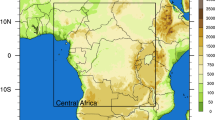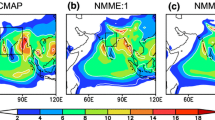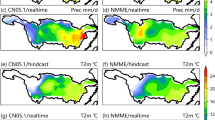Abstract
Accurate prediction of the Asian-Australian monsoon (A-AM) seasonal variation is one of the most important and challenging tasks in climate prediction. In order to understand the causes of the low accuracy in the current prediction of the A-AM precipitation, this study strives to determine to what extent the ten state-of-the-art coupled atmosphere-ocean-land climate models and their multi-model ensemble (MME) can capture the two observed major modes of A-AM rainfall variability–which account for 43% of the total interannual variances during the retrospective prediction period of 1981–2001. The first mode is associated with the turnabout of warming to cooling in the El Niño-Southern Oscillation (ENSO), whereas the second mode leads the warming/cooling by about 1 year, signaling precursory conditions for ENSO. The first mode has a strong biennial tendency and reflects the Tropical Biennial Oscillation (Meehl in J Clim 6:31–41, 1993). We show that the MME 1-month lead prediction of the seasonal precipitation anomalies captures the first two leading modes of variability with high fidelity in terms of seasonally evolving spatial patterns and year-to-year temporal variations, as well as their relationships with ENSO. The MME shows a potential to capture the precursors of ENSO in the second mode about five seasons prior to the maturation of a strong El Niño. However, the MME underestimates the total variances of the two modes and the biennial tendency of the first mode. The models have difficulties in capturing precipitation over the maritime continent and the Walker-type teleconnection in the decaying phase of ENSO, which may contribute in part to a monsoon “spring prediction barrier” (SPB). The NCEP/CFS model hindcast results show that, as the lead time increases, the fractional variance of the first mode increases, suggesting that the long-lead predictability of A-AM rainfall comes primarily from ENSO predictability. In the CFS model, the correlation skill for the first principal component remains about 0.9 up to 6 months before it drops rapidly, but for the spatial pattern it exhibits a drop across the boreal spring. This study uncovered two surprising findings. First, the coupled models’ MME predictions capture the first two leading modes of precipitation variability better than those captured by the ERA-40 and NCEP-2 reanalysis datasets, suggesting that treating the atmosphere as a slave may be inherently unable to simulate summer monsoon rainfall variations in the heavily precipitating regions (Wang et al. in J Clim 17:803–818, 2004). It is recommended that future reanalysis should be carried out with coupled atmosphere and ocean models. Second, While the MME in general better than any individual models, the CFS ensemble hindcast outperforms the MME in terms of the biennial tendency and the amplitude of the anomalies, suggesting that the improved skill of MME prediction is at the expense of overestimating the fractional variance of the leading mode. Other outstanding issues are also discussed.










Similar content being viewed by others
References
Adler RF, Huffman GJ, Chang A, Ferraro R, Xie P, Janowiak J, Rudolf B, Schneider U, Curtis S, Bolvin D, Gruber A, Susskind J, Arkin P (2003) The version 2 global precipitation climatology project (GPCP) monthly precipitation analysis (1979-present). J Hydrometeor 4:1147–1167
Bengtsson L, Schlese U, Roeckner E, Latif M, Barnett TP, Graham NE (1993) A two-tiered approach to long-range climate forecasting. Science 261:1027–1029
Bjerknes J (1969) Atmospheric teleconnections from the equatorial Pacific. Mon Weather Rev 97:163–172
Cane MA, Zebiak SE, Dolan SC (1986) Experimental forecasts of El Niño. Nature 321:827–832
Delecluse P, Madec G (1999) Ocean modeling and the role of the ocean in the climate system. In: Holland WR, Joussaume S, David F (eds) Modeling the earth’s climate and its variability, Les Houches 1997. Elsevier Science, Amsterdam
Deque M (2001) Seasonal predictability of tropical rainfall: probabilistic formulation and validation. Tellus 53A:500–512
Doblas-Reyes FJ, Deque M, Piedelievre J-P (2000) Multi-model spread and probabilistic seasonal forecasts in PROVOST. Q J R Meteorol Soc 126:2069–2088
Gadgil S, Sajani S (1998) Monsoon precipitation in the AMIP runs. Clim Dyn 14:659–689
Gordon C, Cooper C, Senior CA, Banks HT, Gregory JM, Johns TC, Mitchell JFB, Wood RA (2000) Simulation of SST, sea ice extents and ocean heat transports in a version of the Hadley Centre coupled model without flux adjustments. Clim Dyn 16:147–168
Goswami BN (1998) Interannual variations of Indian summer monsoon in a GCM: external conditions versus internal feedbacks. J Clim 11:501–522
Gregory D, Morcrette JJ, Jakob C, Beljaars ACM, Stockdale T (2000) Revision of convection, radiation and cloud schemes in the ECMWF Integrated Forecasting System. Q J R Meteorol Soc 126:1685–1710
Hung CW, Liu X, Yanai M (2004) Symmetry and asymmetry of the Asian and Australian summer monsoon. J Clim 17:2413–2426
Kanamitsu M, Ebisuzaki W, Woollen J, Yang S-K, Hnilo JJ, Fiorino M, Potter GL (2002) NCEP-DOE AMIP-II reanalysis (R-2). Bull Am Meteorol Soc 83:1631–1643
Kim KY (2002) Investigation of ENSO variability using cyclostationary EOFs of observational data. Meteorol Atmos Phys 81:149–168
Krishnamurti TN, Kishtawal CM, Zhang Z, LaRow TE, Bachiochi DR, et al (1999) Improved weather and seasonal climate forecasts from multi-model superensemble. Science 285:1548–1550
Kug JS, Kang I-S (2007) Seasonal climate prediction with SNU tier-one and tier-two prediction systems. Clim Dyn (in press)
Kumar KK, Hoerling M, Rajagopalan B (2005) Advancing Indian monsoon rainfall predictions. Geophys Res Lett 32:L08704
Lorenz EN (1965) A study of the predictability of a 28-variable model. Tellus 17:321–333
Luo J-J, Masson S, Behera S, Shingu S, Yamagata T (2005) Seasonal climate predictability in a coupled OAGCM using a different approach for ensemble forecasts. J Clim 18:4474–4497
Madec G, Delecluse P, Imbrad M, Levy C (1997) OPA release 8, ocean general circulation model reference manual. Internal report, LODYC, Paris
Madec G, Delecluse P, Imbrad M, Levy C (1998) OPA version 8.1, ocean general circulation model reference manual. Technical report no. 11, LODYC, Paris
Marsland SJ, Haak H, Jungclaus J-H, Latif M, Roske F (2003) The Max-Planck-Institute global ocean/sea ice model with orthogonal curvilinear coordinates. Ocean Model 5:91–127
Meehl GA (1987) The annual cycle and interannual variability in the tropical Pacific and Indian Ocean regions. Mon Weather Rev 115:27–50
Meehl GA (1993) A coupled air-sea biennial mechanism in the tropical Indian and Pacific regions: role of the ocean. J Clim 6:31–41
North GR, Bell TL, Cahalan RF, Moeng FJ (1982) Sampling errors in the estimation of empirical orthogonal functions. Mon Weather Rev 110:699–706
Palmer TN, Brankovic C, Richardson DS (2000) A probability and decision-model analysis of PROBOST seasonal multi-model ensemble integrations. Q J R Meteorol Soc 126:2013–2034
Palmer TN, Alessandri A, Andersen U, Cantelaube P, Davey M, et al (2004) Development of a European multi-model ensemble system for seasonal to interannual prediction (DEMETER). Bull Am Meteorol Soc 85:853–872
Pope VD, Gallani ML, Rowntree PR, Stratton RA (2000) The impact of new physical parameterizations in the Hadley Centre climate model: HadAM3. Clim Dyn 16:123–146
Rasmussen EM, Carpenter TH (1982) Variations in tropical sea surface temperature and surface wind fields associated with the Southern Oscillation/El Nino. Mon Weather Rev 110:354–384
Roeckner E, Arpe K, Bengtsson L, Christoph M, Claussen M, Dumenil L, Esch M, Giorgetta M, Schlese U, Schulzweida U (1996) The atmospheric general circulation model ECHAM4: model description and simulation of present-day climate. Report no. 218, Max Planck Institut fur Meteorologie, Hamburg
Rowell DP, Folland CK, Maskell K, Ward MN (1995) Variability of summer rainfall over tropical North Africa (1906–92): observations and modeling. Q J R Meteorol Soc 121:669–704
Saha S, Nadiga S, Thiaw C, Wang J, et al (2006) The NCEP climate forecast system. J Clim 19:3483–3517
Saji HN, Goswami BN, Vinayachandran PN, Yamaghata T (1999) A dipole mode in the tropical Indian Ocean. Nature 401:360–363
Shukla J (1981) Dynamical predictability of monthly means. J Atmos Sci 38:2547–2572
Shukla J, et al (2000) Dynamical seasonal prediction. Bull Am Meteorol Soc 81:2493–2606
Smith TM, Reynolds RW (2004) Improved extended reconstruction of SST (1854–1997). J Clim 17:2466–2477
Sperber KR, Palmer TN (1996) Interannual tropical rainfall variability in general circulation model simulations associated with the Atmospheric Model Intercomparison Project. J Clim 9:2727–2750
Turner AG, Inness PM, Slingo JM (2005) The role of the basic state in the ENSO-monsoon relationship and implications for predictability. Q J R Meteorol Soc 131:781–804
Uppala SM, Kållberg PW, Simmons AJ, Andrae U, da Costa Bechtold V, et al (2005) The ERA-40 re-analysis. Q J R Meteorol Soc 131:2961–3012
Wang B (1995) Interdecadal changes in El Nino onset in the last four decades. J Clim 8:267–285
Wang B, An SI (2005) A method for detecting season-dependent modes of climate variability: S-EOF analysis. Geophys Res Lett 32:L15710. doi:10.1029/2005GL022709
Wang B, Wu R, Li T (2003) Atmosphere-warm ocean interaction and its impact on Asian–Australian monsoon variation. J Clim 16:1195–1211
Wang B, Kang I-S, Lee J-Y (2004) Ensemble simulations of Asian–Australian monsoon variability by 11 AGCMs. J Clim 17:803–818
Wang B, Ding QH, Fu XH, Kang I-S, Jin K, Shukla J, Doblas-Reyes F (2005) Fundamental challenge in simulation and prediction of summer monsoon rainfall. Geophys Res Lett 32:L15711
Wang B, Yang J, Zhou T, Wang B (2007a) Interdecadal changes in major modes of Asian-Australian monsoon interannual variability. Clim Dyn (in press)
Wang B, Lee J-Y, Kang I-S, Shukla J et al (2007b) Assessment of the APCC/CliPAS multi-model seasonal hindcast. Clim Dyn (Submitted)
Weare BC, Nasstrom JS (1982) Examples of extended empirical orthogonal function analyses. Mon Weather Rev 110:481–485
Webster PJ, Yang S (1992) Monsoon and ENSO: selectively interactive system. Q J R Meteorol Soc 118:877–926
Webster PJ, Moore AM, Loschnigg JP, Leben RR (1999) Coupled ocean-atmosphere dynamics in the Indian Ocean during 1997–1998. Nature 401:356–360
Wolff JE, Maier-Reimer E, Legutke S (1997) The Hamburg Ocean primitive equation model. Technical report no. 13, Deutsches Klimarechenzentrum, Hamburg
Wu R, Kirtman B (2004) Impacts of the Indian Ocean on the Indian summer monsoon-ENSO relationship. J Clim 17:3037–3054
Wu R, Kirtman B (2005) Roles of Indian and Pacific Ocean air-sea coupling in tropical atmospheric variability. Clim Dyn 25:155–170
Xie P, Arkin PA (1997) Global precipitation: a 17-year monthly analysis based on gauge observations, satellite estimates, and numerical model outputs. Bull Am Meteorol Soc 78:2539–2558
Yasunari T (1991) The monsoon year—a new concept of the climatic year in the tropics. Bull Am Meteorol Soc 72:1331–1338
Zebiak SE, Cane MA (1987) A model of El Niño-Southern Oscillation. Mon Weather Rev 115:2262–2278
Acknowledgments
This work is supported by APEC Climate Center as a part of APCC international project (CliPAS). The authors also thank the DEMETER project for providing their data. Wang acknowledges support from IPRC, which is in part supported by JAMSTEC. This is the SEOST publication number 7199 and IPRC publication number 478.
Author information
Authors and Affiliations
Corresponding author
Rights and permissions
About this article
Cite this article
Wang, B., Lee, JY., Kang, IS. et al. How accurately do coupled climate models predict the leading modes of Asian-Australian monsoon interannual variability?. Clim Dyn 30, 605–619 (2008). https://doi.org/10.1007/s00382-007-0310-5
Received:
Accepted:
Published:
Issue Date:
DOI: https://doi.org/10.1007/s00382-007-0310-5




